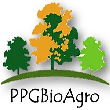Banca de DEFESA: LARISSA LEMES DOS SANTOS
Uma banca de DEFESA de MESTRADO foi cadastrada pelo programa.DISCENTE : LARISSA LEMES DOS SANTOS
DATA : 20/02/2024
HORA: 13:30
LOCAL: Alta Floresta, MT.
TÍTULO:
Establishment of DNA extraction protocol and Analysis of genetic diversity of Mouriri guianensis Aubl.
PALAVRAS-CHAVES:
CTAB, Genetic variability, Roncador, Polymerase Chain Reaction.
PÁGINAS: 77
GRANDE ÁREA: Ciências Biológicas
ÁREA: Genética
SUBÁREA: Genética Vegetal
RESUMO:
Belonging to the Melastomataceae family, Mouriri guianensis Aubl., popularly known as "roncador", is a fruit tree consumed fresh by the population and ichthyofauna. It possesses medicinal properties for the treatment of various ailments and is recommended for beekeepers as bees are its primary pollinators. Therefore, it is of great interest to researchers due to its ecological, economic, and medicinal potential. The objective of this study was to establish a DNA extraction protocol for the species Mouriri guianensis and to evaluate the diversity and genetic structure of natural populations using ISSR (Inter Simple Sequence Repeat) molecular markers. Leaf material sampling was conducted in four populations naturally occurring in the Pantanal biome (Barão do Melgaço, Rio São Lourenço, and Rio Jauru) and the Amazon (Rio Sepotuba). DNA extraction was based on the CTAB (Cetyltrimethyl Ammonium Bromide) method, and DNA amplification tests were performed via PCR (Polymerase Chain Reaction). For genetic diversity and population structure analyses, amplification tests were conducted, and subsequently, 8 (eight) primers were selected. DNA extraction protocols for M. guianensis containing the highest CTAB concentrations (5%) were the most efficient, affecting the quality and quantity of extracted DNA and providing a product of greater integrity. Efficiency was also determined by PCR amplification reactions. Regarding molecular characterization, the 8 ISSR primers amplified a total of 127 fragments, of which 98% were polymorphic. AMOVA (Analysis of Molecular Variance) revealed that the greatest genetic diversity was among populations (52%), with the highest diversity indices found for the Rio Jauru population (H=0.28; I=0.41, and P%=71.65). For the dissimilarity matrix, the shortest distance occurred between individuals 9 and 10 (0.15), both from the Rio Sepotuba population, while individuals 5 (Rio Sepotuba) and 32 (Rio Jauru) (0.76) were the furthest apart. Clustering by the UPGMA method formed five distinct groups, with individuals grouped according to collection location; for example, the 14 individuals from the Rio Sepotuba population were allocated to the first group. Bayesian analysis revealed the formation of two main genetic groups according to different biomes, with UPGMA also forming groups using the same criterion, although within the Pantanal biome, there was a subdivision into collection locations. Principal Coordinates Analysis corresponded to UPGMA and Bayesian clustering, highlighting the isolation of the Rio Sepotuba population (Amazon). The DNA extraction protocol with 5% CTAB (with Proteinase K) enabled PCR amplification of the samples. ISSR molecular markers showed genetic diversity among Mouriri guianensis individuals, revealing the first evidence of population structuring for the species among collection locations and the original biome. The greatest diversity was found at the interpopulation level, with the Rio Jauru Pantanal population exhibiting the highest diversity, and the only Amazonian population (Rio Sepotuba) being the most genetically isolated. The species native to the Amazon and Pantanal Matogrossense demonstrates potential for ensuring its maintenance and effective conservation.
MEMBROS DA BANCA:
Presidente - 32143101 - ANA APARECIDA BANDINI ROSSI
Externo ao Programa - 70141009 - OSCAR MITSUO YAMASHITA
Externo à Instituição - 019.240.091-61 - ELIANE CRISTINA MORENO DE PEDRI -
Externo à Instituição - 607.835.671-20 - EULÁLIA SOLER SOBREIRA HOOGERHEIDE - EMBRAPA



